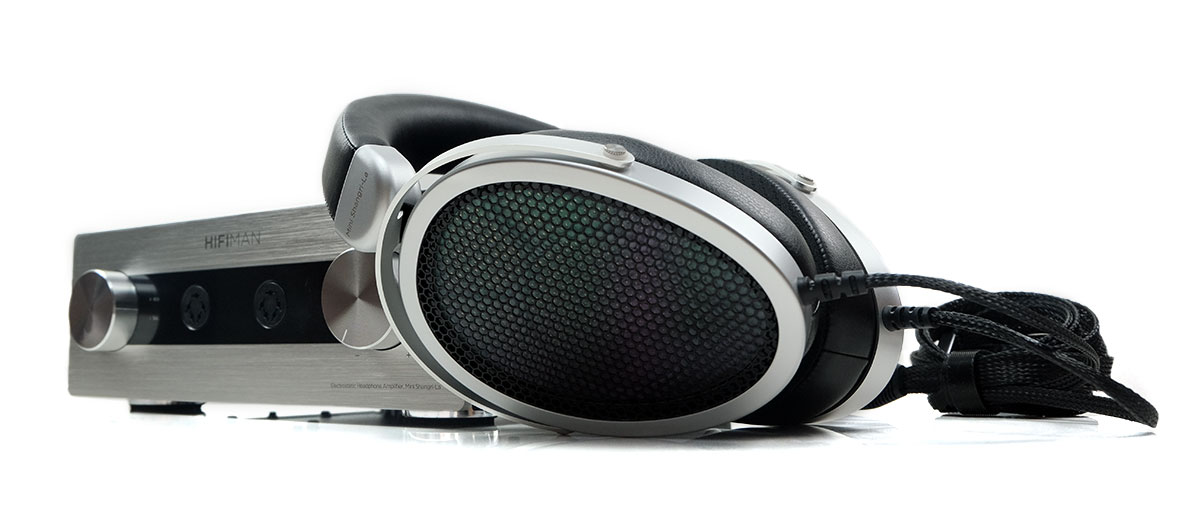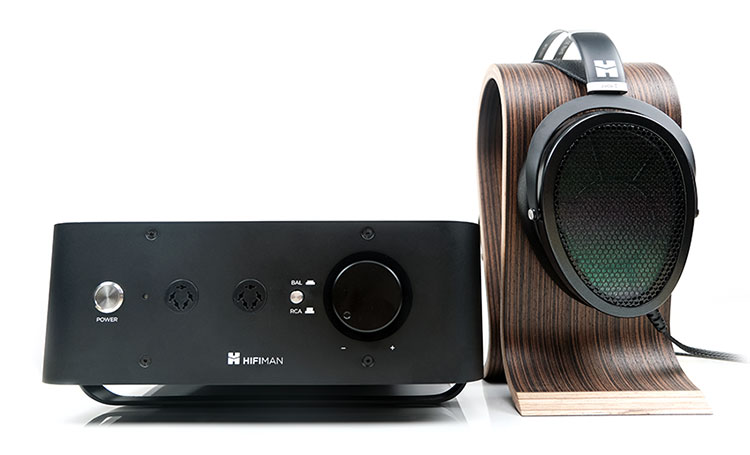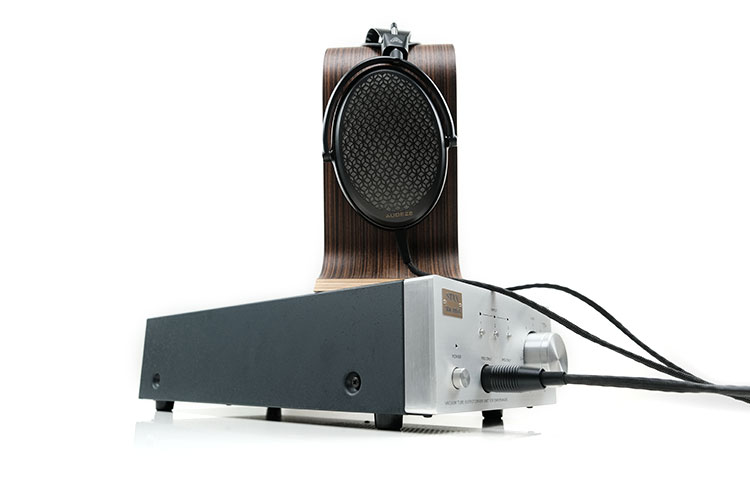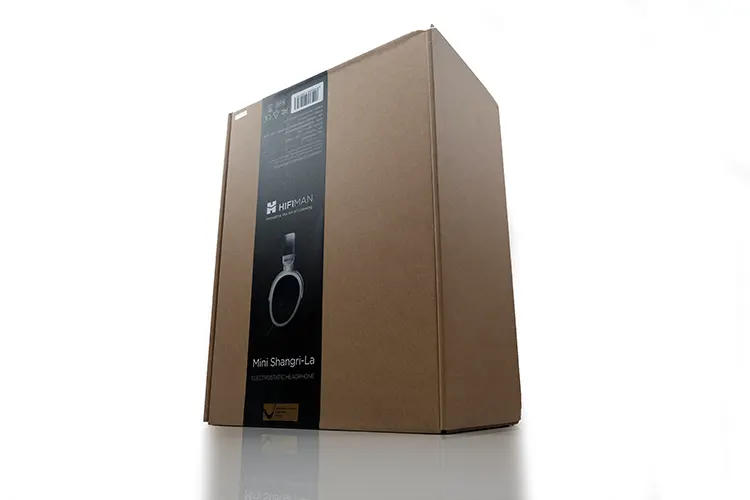Selected Comparisons
The following comparisons to the HIFIMAN Mini Shangri-La were completed in three ways: as a system when compared to the Jade II, the headphones only using the Mini Shangri-La amplifier to compare to the SR-L300 Limited, and amplifier versus amplifier using the Mini Shangri-La headphones.
HIFIMAN Jade II
The HIFIMAN Jade II was the precursor to the launch of the Mini Shangri-La, making its debut in 2019. Much of what is inside the new is inherited from the old and then refined or improved on.
Headphone Technical
This review has already discussed the Jade II setup extensively, so I will keep it brief here. In my eyes, the Mini Shangri-La is an evolution of the Jade II system.
They share many features such as the headphone driver with its iridescent color scheme, the stock cable, the amplifier potentiometer, and the dual pro bias output.
Both headphones use large ovoid electrostatic drivers, and both headphones are designed with nanometer diaphragms and nanoparticle coatings with acoustically transparent dust covers.
The biggest change to the design of the headphones is the switch to the new generation single headband frame pulled from the likes of the Edition XS.
It is lighter than the older Jade II headphones design, more articulate, and might fit a wider range of head sizes. However, it feels a little cheaper and I still pressure the batter scalp comfort from the Jade II pressure strap.
Amplifier Technical
The Mini Shangri-La amplifier changes seem more significant, at least externally. Inside, the topology might have similar circuitry to the Jade II amplifier with some refinements.
However, subjectively there is some improved resistance and clicking when using the 21-step potentiometer so, it might have been replaced with a higher-grade version.
There is also a shift from the tight and difficult-to-service black barrel housing of the Jade II design to a more mainstream box ‘HiFi’ shape drawn from the EF400 form factor. Place side by side, the Mini Shangri-La amplifier looks the classier and cleaner of the two amplifiers and lighter by almost 1 kg.
Inputs and outputs remain similar with dual RCA and balanced XLR on the rear panel and the capability to drive two headphones at the same time from the front panel.
Also, the Jade II’s wobbly input select switch has been replaced by a much nicer multifunction dial selector with LED light indicators.
Performance
Of the two headphones, the Mini Shangri-La has a smoother-sounding performance. When paired with the Mini Shangri-La amplifier, you can also subjectively tell how much firmer those mids are on the Mini Shangri-La headphones compared to the more even Jade II mids.
I would argue, however, that the Jade II mid-bass is slightly more noticeable, creating a stronger perception of depth and height in its soundstage quality.
Neither headphone will set the world on fire for sub-bass power and solidity with noticeable roll-off beyond 80Hz but if you absolutely must have the strongest presence around 100Hz the Jade II has a very slight edge.
The Mini Shangri-La headphones go about things a little differently. There is more fullness and warmth from the upper bass into the lower mids with an improved level of vocal presence around 1-2k.
You will subjectively perceive your positioning as a little closer to the stage with the Mini Shangri-La headphones giving vocals more of what I like to describe as an ’emotional engagement’.
That engagement is helped by a noticeably thicker vocal and midrange instrument timbre and a more natural and coherent tonal quality throughout. The Jade II’s slight drop through the lower mids renders the midrange more uneven-sounding, suppressing instrumental fullness.
No contest for the amplifier comparison. Going balanced with both, the Mini Shangri-La amp sounds more dynamic, fuller on the lows, and with a more vibrant vocal presentation.
The Jade II amplifier sounds flatter with the Mini Shangri-La headphones. It is not as expansive or as well separated, almost as if it was delivering the single-ended of the Mini Shangri-La’s balanced output.
Stax SR-L300 Limited
The STAX SR-L300 Limited was launched in 2019 and is a commemoration edition of the SR-L300 to celebrate the 80th anniversary of the STAX foundation, (800 units limited sale).
Technical
The SR-L300 Limited headphones use a set of SR-L700 drivers inside an SR-L300 body and are sold for somewhere between the price of each unit.
The SR-L300 Limited pads are not L300 pads but rather L500 MK1 pads of better quality than their smaller sibling’s pads. Arguably, the SR-L300 Limited is a slice of every L-Series MK1 headphone STAX sold in one neat package.
I believe the big difference between this driver and the L300 stock version is the superior damping of the stator with a second material bonded via heat diffusion.
STAX has called this “MLER”, (Multi-Layer Elect Rode), an ellipse sound element and something that they use on their higher Lambda series top models (in this case the L700). The whole stator damping design should thus be the better driver for reducing unwanted resonance.
Design
The Mini Shangri-La has a larger driver packed into a form factor derived from HIFIMAN Edition XS planar headphones making it the bulkier looking of the two headphones.
The weight difference also favors the Limited at 323g compared to the Mini Shangri-La at 374g and you can feel that minor difference when in use.
I found the Stax plastics to be more refined and intricate, however, I always worry about its questionable plastic yoke durability under stress, more so than the tougher Mini Shangri-La yokes.
The Mini Shangri-La uses an oval ear cup with a similar height to the Stax design. However, its pads offer better width and a superior ergonomic shape providing more comfort directly around the ears compared to the flatter and smaller SR-L300 Limited pads.
I find the pressure dissipation from the strap design on the SR-L300 Limited to be superior. It provides a more balanced and secure feel on my head for longer listening sessions when compared to the narrower Mini Shangri-La headband.
Performance
The SR-003 Limited is significantly darker through the mids but also slightly weightier in the lows with more amplitude and extension in the upper-treble.
The Mini Shangri-la headphones deliver a more open midrange, better vocal presence, and sound more filled-in throughout this region. Notes towards the low-end, somewhere around 80-100Hz have a reduced bass fundamental which means a little less weight compared to the Stax.
That low-end response is probably the first area you will pick up and it can change the dynamic and emphasis on recordings significantly when A/B’ing with the Mini Shangri-La headphones.
For example, Billie Elish’s “The Greatest” from her recent Hit Me Hard And Soft album has a lower register kick drum that delivers a firm and distinct thud with the Stax but a lighter softer quality on the Mini Shangri-La.
It’s almost invisible in presence when played through the HIFIMAN headphones with the primary focus on the better body, weight, and presence of Billie’s vocal performances.
On the Stax, you get more definition and presence that draws your ear further down into the recording. The darker 2-5k dip on the Stax can create a more congested sound through the upper mids when instruments get busier though vocals remain largely unaffected.
The Stax staging is generally deeper with more energy around 8-10k creating some additional upper harmonic sheen but I would opt for the more coherent tonal quality of the Mini Shangri-La mids and highs.
Stax SRM-007tII
I have never officially done a review of the SRM-007tII. Though discontinued it should provide a useful comparison given its similar SRP price point. You can acquire a used unit of the SRM-007tII for just under $1000 on eBay.
Technical
Unlike the discrete transistor-based solid-state topology of the Mini Shangri-La amplifier, the SRM-007tII is a hybrid tube and solid-state desktop amplifier. It uses a mix of 4 dual-triode 6FQ7(6CG7) tubes for its input and a solid-state dual FET input Class A output stage.
The two amps are Pro-Bias 580V compatible with dual 5-pin connectors to run two electrostatic headphones at the same time.
Volume control is quite different on both, however. The Stax uses a smooth non-stepped attenuator with channel balancing capability (rear part of the knob) and volume control functionality (front part of the knob). The Mini Shangri-La uses a 21-step attenuator with superior resistance than the vaguer Jade II pot.
Both amplifiers offer balanced 3-pin XLR and unbalanced RCA inputs and outputs with switching controls.
The SRM-007tII differs with 2 RCA inputs rather than one on the rear panel with separate button-controlled input selectors as opposed to what I might consider a more intuitive input selector dial on the Mini Shangri-La amplifier.
Design
I think there are more similarities than differences in the design of these two amplifiers.
The Mini Shangri-La certainly follows the classic Stax mix of brushed aluminum and black paneling for the outer aesthetic though the core design language is pulled from the EF400 than following the lead of Stax.
Despite the very different dimensions, I would classify the Mini Shangri-La amplifier as the bigger of the two due to its additional 1 kg in weight and wider form factor. The Stax SRM-007tII is deeper but that narrow rectangular shape and lower weight make it much easier to slip into tight spots on the rack.
Bear in mind, however, that the Stax SRM-007tII has a grilled top panel with tubes so it’s not the type of amplifier you should be stacking anything on top. It is unlikely you can stack much below given its narrow but long form factor.
The I/O layouts have some advantages for each amplifier. I prefer the simpler multifunction dial and LED status check of the Mini Shangri-La front panel.
However, the Stax SRM-007tII’s front panel power switch is easier to operate in a rack system. The rear position of the Mini Shangri-La power button could be challenging in tight spaces.
The Stax SRM-007tII also has that additional dual RCA input giving it some additional connectivity flexibility though both amplifiers will allow you to connect two electrostatic headphones at the same time which always helps for comparisons.
Performance
I have seen comments that the Mini Shangri-La amplifier might be ‘bass-light’. Compared to the SRM-007tII I would argue that its bass emphasis is slightly skewed to mid-to-upper bass rather than 100Hz downwards.
The SRM-007tII does extend more with the Mini Shangri-La headphones and you can pick a slightly enhanced sub-bass coloration though it is by no means a heavyweight sub-bass response. Rather it has a little less mid-to-upper bass bloom, increasing perceived bass to mids separation.
The Mini Shangri-la amplifier’s solid-state topology brings more energy to recordings though not necessarily a better level of dynamic range with the Stax amplifier producing a slightly blacker background.
Rather its punch and driver is more in your face with a more physical presentation and enhanced midrange body compared to the relatively pristine and pure tone of the Stax tube amplifier.
The Mini Shangri-La amplifier’s imaging feels more intimate with vocals sounding more pronounced and lower mids instruments sounding more visceral.
The Stax dials the midrange aggression back a bit more but injects more space into its soundstage creating a slightly more holographic dimension. Of the two, its staging is deeper and taller with more treble contrast and sparkle.
I prefer the Mini Shangri-La for recordings that need driving rhythm and pace. It sounds more physical with a slightly rounded and smoother vocal tone.
The Stax amplifier is ideal for recordings that need to breathe, with more depth and slightly better dynamic range to tease out those delicate moments.
My Verdict
HIFIMAN has been smart with the tuning of the Mini Shangri-La system by creating a sound signature that is first and foremost enjoyable without feeling the need to over-emphasize that it is an electrostatic headphone in the first place.
Quite often, when we say it’s an EST headphone the listener feels almost cheated if the highs are not ‘higher’ than any other headphone or the speed is faster than the speed of light.
What you get instead is an articulate but very smooth and natural-sounding set of headphones that are easily one of the company’s most enjoyable sound signatures for vocal lovers, or people like me.
Throw in a vastly improved amplifier, both in terms of design and performance, and the overall package is one that I would describe as an astute sound system purchase for lovers of the standards, the classics, or live band music.
HIFIMAN Mini Shangri-La Technical Specifications
- Headphones
- Frequency Response: 7Hz–120kHz
- Bias voltage: 550V–650V
- Weight: 13.2oz (374g)
- Amplifier
- Type Electrostatic
- Weight 5.82kg
- Dimensions 255mm W x 251mm L x 93 mm H






